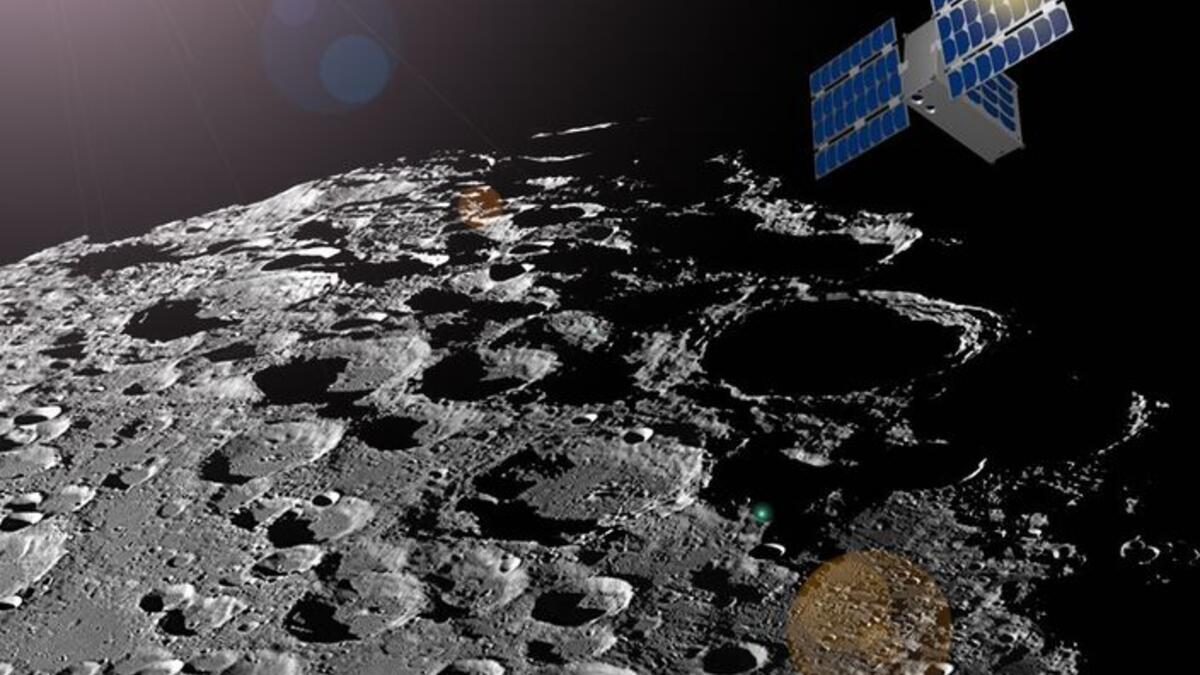ASU to help high schoolers build satellites in national CubeSat competition

An artist's rendering of a shoebox-size CubeSat satellite orbiting the moon. Image by Sean Amidan/ASU/SpaceTREx
Today the White House announced the creation of a nationwide “CubeSat competition” that partners high school students with leading universities for the development and operation of small space satellites. The announcement was part of the festivities surrounding White House Astronomy Night on Oct. 19.
The CubeSat competition is being organized by Cornell University and the Museum of Science Fiction in Washington, D.C. Seven universities, including Arizona State University, will be participating partners. ASU’s participation will be led and organized by Jim Bell, director of the ASU Space Technology and Science (“NewSpace”) Initiative, and Ed Finn, director of ASU’s Center for Science and the Imagination.
CubeSats are a new and revolutionary way of doing space science. Because of their small size (roughly the size of a shoebox) and low cost of construction and operation, CubeSats have the potential to democratize space science, providing opportunities for students and citizens to design and even operate missions of their own. CubeSats are typically carried into space as secondary payloads on larger, more traditional space missions.
“The CubeSat competition provides a great opportunity for students to get direct, hands-on experience in space science, engineering and exploration,” said Bell, an ASU professor in the School of Earth and Space Exploration. “Part of our mission is to engage the community, especially young people, in the excitement of science, technology, engineering and mathematics (STEM) topics like space exploration.”
“This contest invites a new generation of explorers, researchers and entrepreneurs to dream big,” said Finn, an assistant professor in the School of Arts, Media & Engineering and the Department of English. “Space has long been a canvas for great stories and grand ambitions, from the Apollo Program to ‘Star Trek,’ and the CubeSat competition gives winners the chance to see their ideas not just realized but launched into orbit.”
In the CubeSat competition, teams of high school students nationwide will propose inexpensive (less than $10,000) CubeSat missions to test technologies or conduct small-scale science experiments in space. Those proposals will be submitted by early 2016 and judged during the spring, with winners announced in summer 2016.
The students will be encouraged, but not required, to reach out to participating universities, NASA Centers or aerospace companies for help with their proposal as they see fit.
CubeSat competition judges will work with participating universities to match up their researchers’ expertise with the best-fit high school proposals (based on geography, research or technology synergies, etc.). It is expected that the universities will develop the technology and engineering solutions needed to make the high school students’ proposals functional and fit for flight.
University researchers and high school students will interact by teleconference, videoconference and email. Some universities might bring students to campus to participate in various aspects of the design and build work. In some cases, university teams may be able to carve off one component of the CubeSat system for the students to work on and then integrate it into the larger system later in the program.
The collaborative high school-university teams will apply for free NASA CubeSat launches through its CubeSat Launch Initiative.
For Bell, the benefits of the competition are both inspirational and real.
“The kinds of skills needed to plan, design, test, build and fly a spacecraft mission are directly translatable to a wide variety of careers in STEM and high-tech fields,” he said. “Employers out there want not only book-smart students for these careers, but students who have gotten their hands dirty — literally or figuratively — building real-world mechanical, electrical or even software systems.
“Projects like this provide a great opportunity for practical, pragmatic teaching moments for budding engineers and scientists, as well as great foundational skills in teamwork, critical thinking and problem solving even for students who do not go directly into careers in those fields.”
Read more
More Science and technology

What does a spacecraft, a skeleton and an asteroid have in common? This ASU professor
NASA’s Lucy spacecraft will probe an asteroid as it flys by it on Sunday — one with a connection to the mission name.The asteroid…

Hack like you 'meme' it
What do pepperoni pizza, cat memes and an online dojo have in common?It turns out, these are all essential elements of a great…

ASU professor breeds new tomato variety, the 'Desert Dew'
In an era defined by climate volatility and resource scarcity, researchers are developing crops that can survive — and thrive —…

